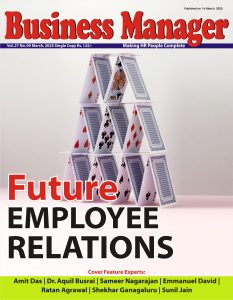The last two years have been fraught with change for businesses, workplaces, and professionals alike. Two years after the economy came to a grinding halt amida pandemic, the business ecosystem is settling into its post-pandemic ‘normal.’ In this resulting reimagined, post-COVID workplace, the role of the organization’s HR has not only changed, but also become more crucial than ever before. So, what’s the future of HR?
Battling the Great Resignation
In the immediate aftermath of the pandemic, HR professionals were in firefighting mode, dealing with what is now being termed as ‘the Great Resignation.’ The Indian IT sector witnessed record attrition with various global leaders’churn rates soaring upward of 20% after the COVID-19 outbreak.
With attrition being the highest in 10 years, HR teams continue to navigate the fallout from the Great Resignation. Organizations are coming forth with employee-centric workplace policies that align with the workforce’s evolving values and goals. Reconceived reward mechanisms, conducive work culture, and a keen focus on employee development are all factored into post-pandemic retention strategies.
Also Read: Making organisations more productive : Deepak Pandey
More than just handing out salary hikes, HR leaders must focus on the changing priorities of the workforce. They need to revisit their policies in order to offer a better quality of work life balance to their employees by focusing on critical factors like flexible work arrangements and focus on mental health and well-being. After reeling under the high-stress period during the pandemic, employees are looking for a more holistic and positive workplace experience. There is no acceptance for poor work/life balance that could lead to burnout and inadequate compensation.
But, these are just the first steps; the HR’s role will need to evolve further. Rather than just looking at the administrative tasks around hiring and onboarding employees, the HR department will now be instrumental in helping people meet their career goals. SumTotal’s ‘HR in a Changing World’ report found that 94% of employees would stay at a company longer if it invested in their growth and career development.
The HR leader would be required to align individual employee goals to the business goals, upskilling and reskilling the workforce to remain relevant in the long run. Achieving optimal employee engagement through tailored learning programs to boost employee experience, decrease attrition and contribute to overall business success.
Spotlight on learning and development
Employee development is a core tenet of a new-age employee retention strategy. Fortunately, technological innovation has enabled future-focused HR teams to deploy the tools required to enable continuous workplace learning. Holistic, tech-led platforms are widely used to empower professionals with in-demand skills that will accelerate their career progression and strengthen the company’s talent pool.
To ensure that this is successfully implemented, HR leaders need to focus on 3 aspects –
- Hiring the right people – Making talent a top priority to get the job done;
- Promoting from within – Offer career growth opportunities to existing talent; and
- Identifying the skills required for the organization –Nurture in-demand skills by offering the tools to upskill/reskill in relevant domains
When employees are given the resources to advance their careers, they feel naturally more involved and connected to their workplace. HR departments must continue to provide such opportunities combined with the tailored employee benefits to create an engaged workforce.
Diversity and Inclusion
The Indian IT sector is actively trying to recruit more women, and for good reason. As per Great Place To Work an organization stands to gain 5.4 times higher retention and higher revenue growth by creating a diverse and inclusive workplace. More than anything else, D&I corresponds to values that are important to the new-age labour force.
As per the CMIE, the number of women job seekers in India fell by 34% in 2021 owing to the pandemic and its impact. Burdened by more work and family responsibilities, women were disproportionately more susceptible to job loss and burnout globally. Deloitte research found that 52% of women employees faced non-inclusive behaviour in their workplace, further adding insult to injury.
Diversity and Inclusion will, therefore, become a key area of focus for HR leaders in the present and will continue to be crucial in the future. HR departments must work towards bringing more women into the workforce, employing a flexible work culture that is supportive of women professionals.
Furthermore, HR teams will need to work on closing the gender pay gap, which is much wider post COVID. According to the ADP Research Institute’s People at Work 2021 study, only 65% of women in India received a bonus or hike when taking on extra responsibilities as opposed to 70% of men. This warrants a careful look at the gender pay gap and consistent efforts towards achieving pay parity, to compensate each individual based on merit, irrespective of gender.
In conclusion
The HR department has its work cut out for the next few years as the new normal continues to play out. However, with more responsibility, the HR team must also receive more power to make systemic, organization-wide changes. C-suite level HR professionals must get a seat at the table and become more involved in the business. In doing so, organizations can ensure that every important business decision is taken while considering the company’s most important asset – its people.






















Add comment